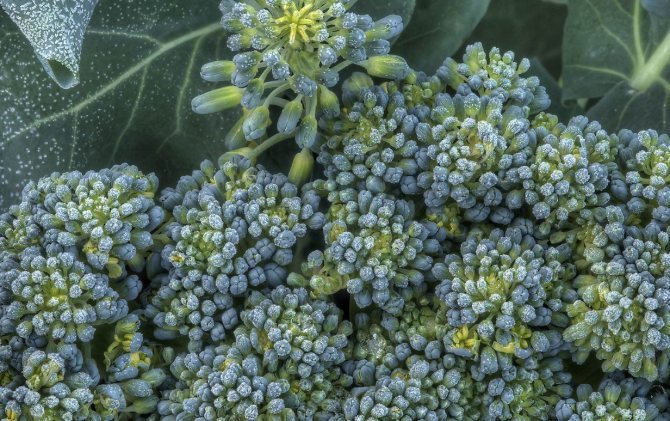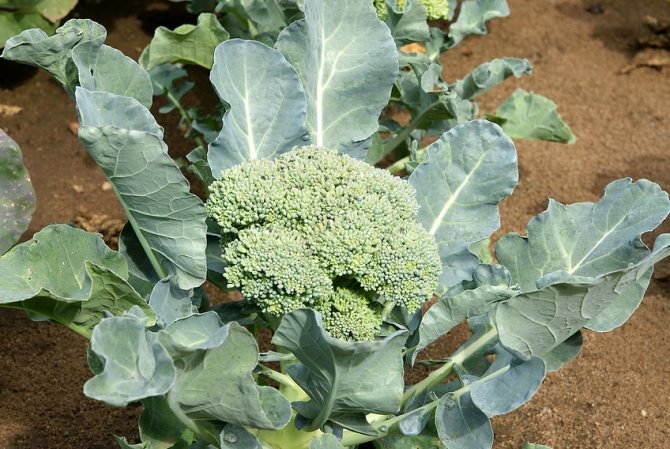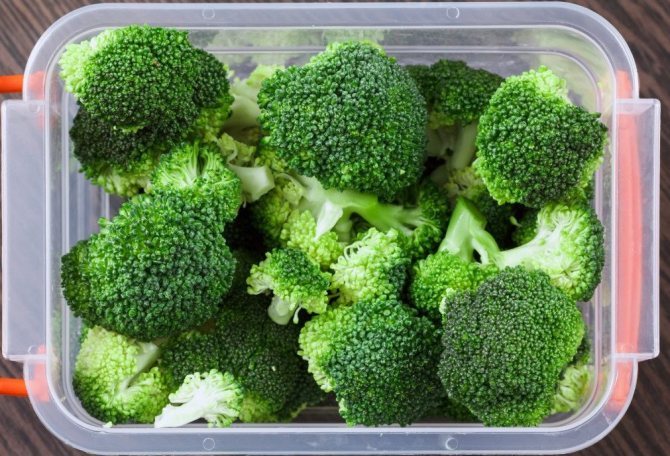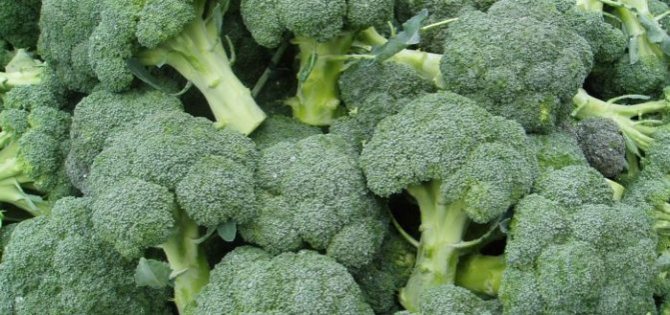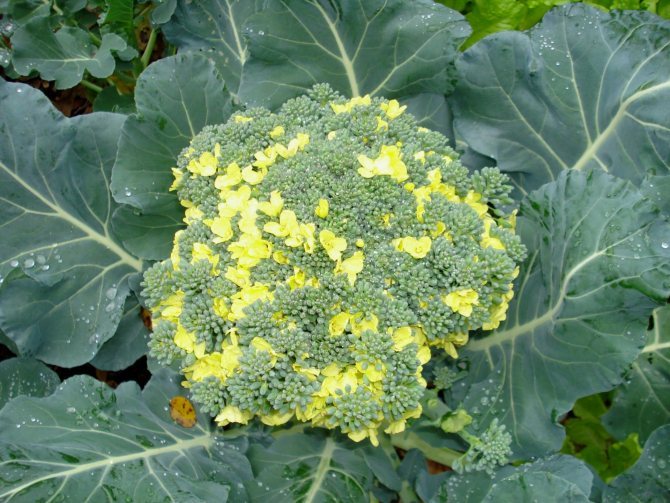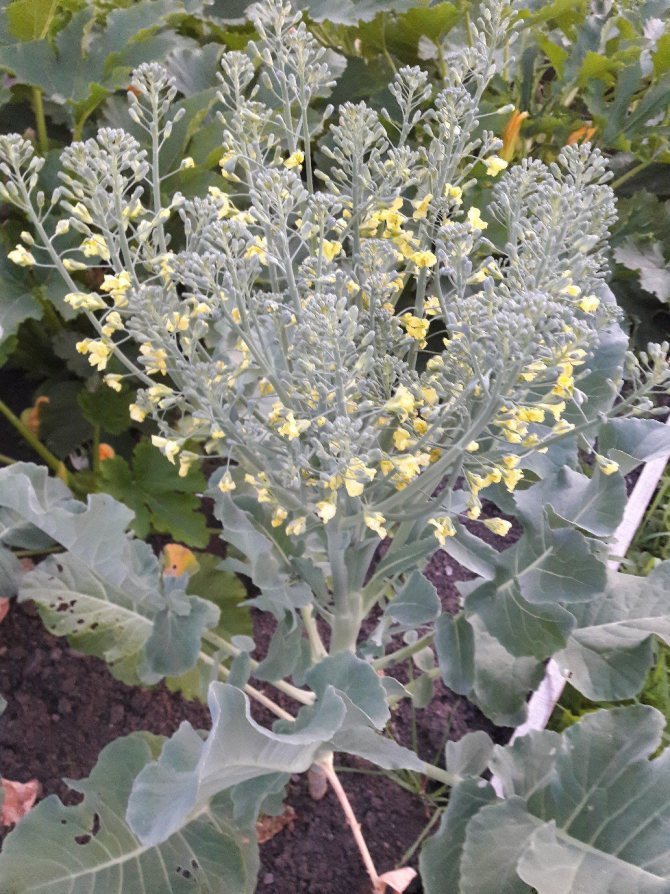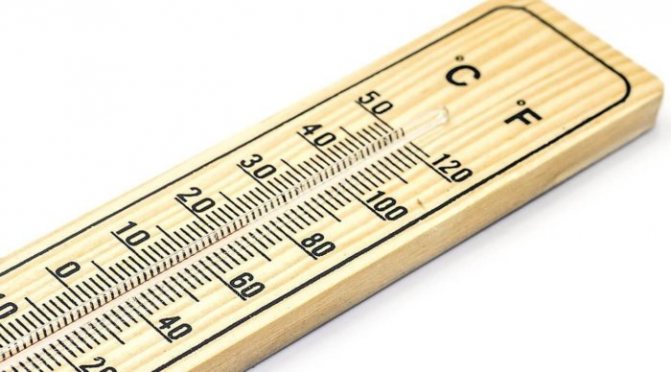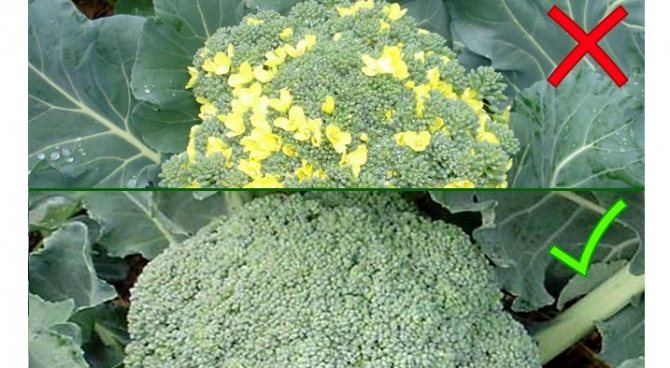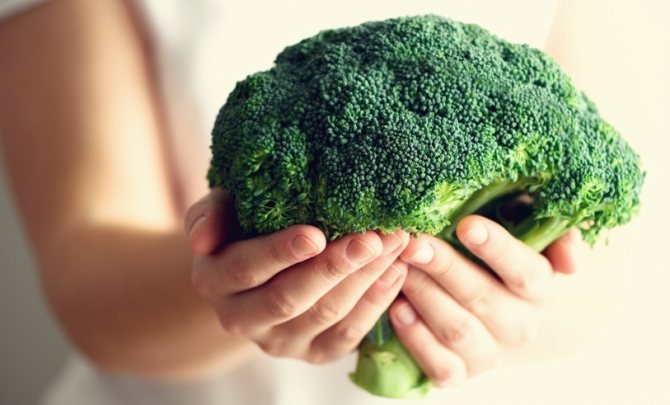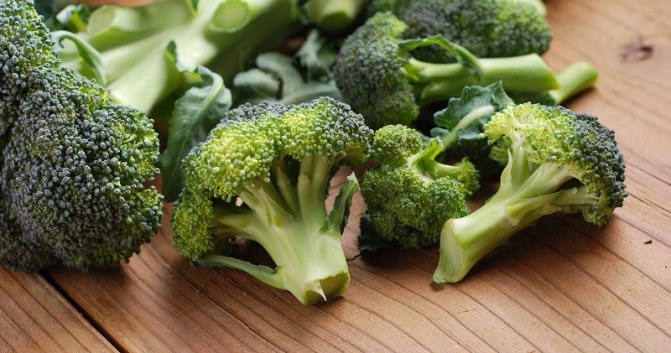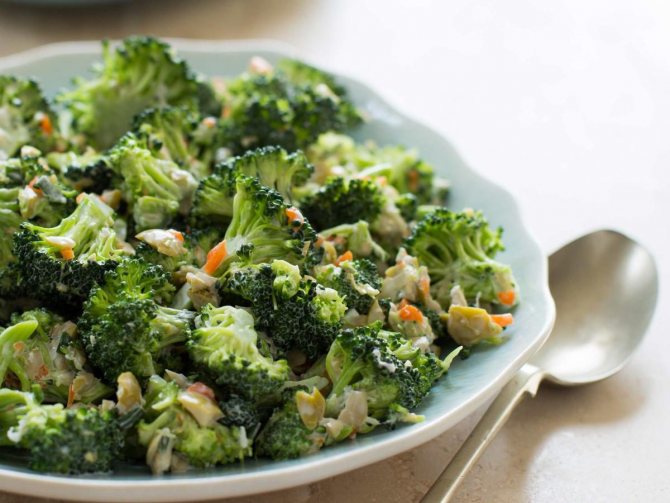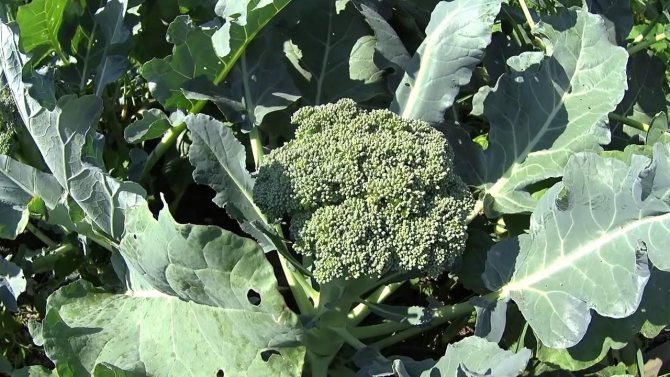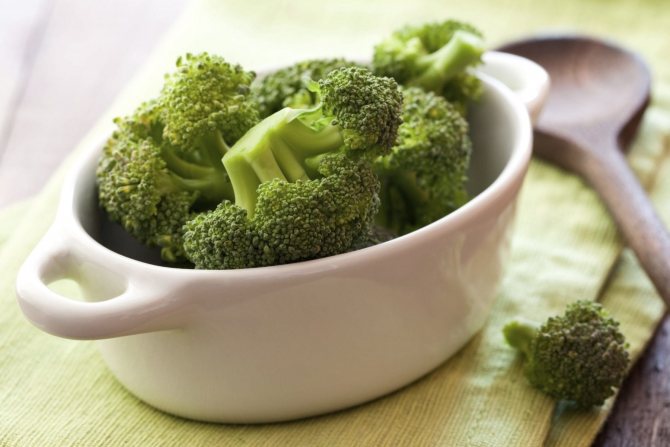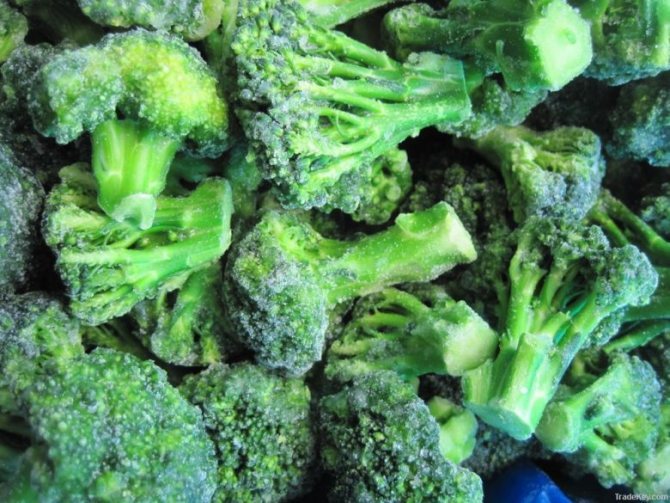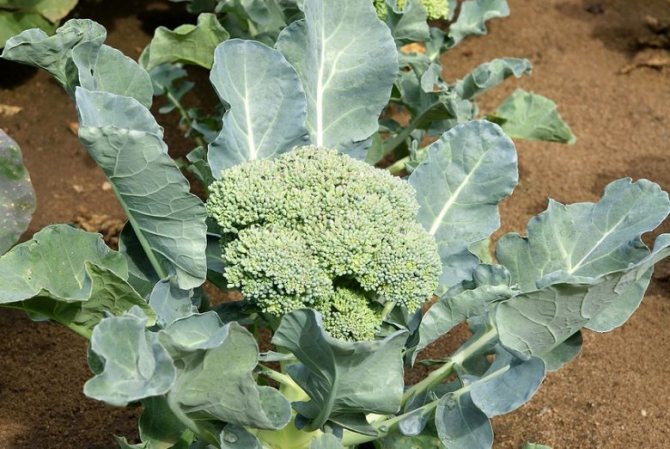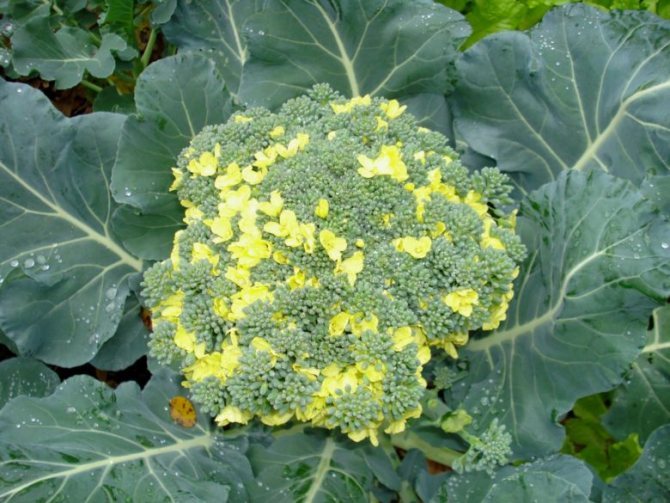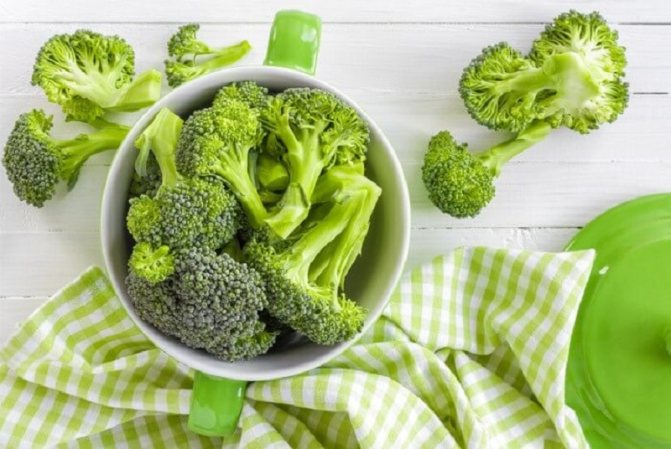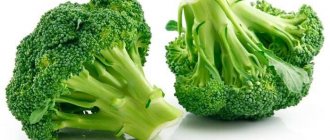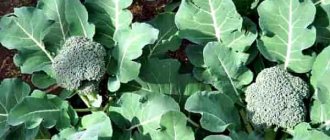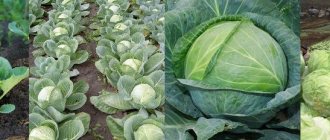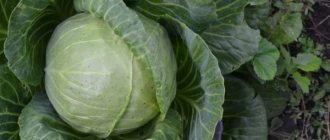Broccoli, the rival of cauliflower, is becoming more popular every year. The secret is in the nutritional composition of a vegetable rich in phosphorus, calcium, magnesium, vitamins A, C, E, PP, group B. The green and purple heads contain vegetable protein and amino acids that are indispensable for children and those who follow a diet. In order for the vegetable to last as long as possible, you need to know how to store broccoli at home. Everyone can cope with the task, it is enough to know simple rules and heed the recommendations.
It's time to harvest
Let's first define the varietal assortment. Of the 37 varieties of the register of breeding achievements, there is not a single one that breeders would recommend for fresh winter storage - only for home cooking.
According to the growing season, all varieties are divided into:
- early ripening varieties ripen at 75-90 days;
- mid-season and late species ripen for 105 days or more.
To extend the consumption period, it is better to sow cabbage of different ripening periods, as well as select those varieties that give lateral heads. For example, the Linda hybrid, after cutting off the main head, gives 7 side heads, 50-70 g each, but Monterello gives only one main head weighing 700 g.
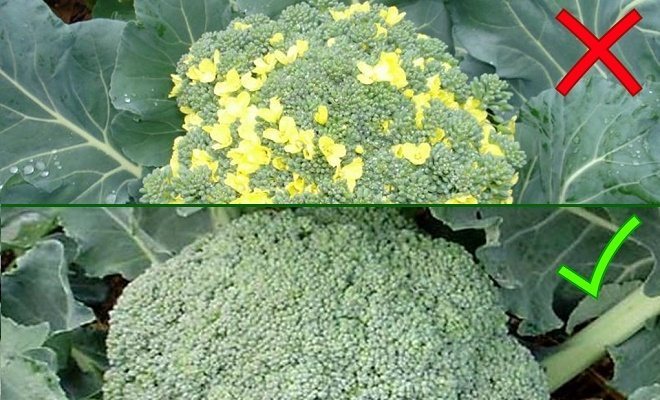
So it's time to harvest. The following tips will help keep your broccoli fresh for a while:
- choose dense heads with a diameter of 13-18 cm;
- we select dark green, and with yellow spots, overripe - to the side;
- we cut off the heads of cabbage 10-12 cm below the base of the head;
- we leave the stems in the garden to re-harvest young inflorescences (for certain varieties).
Harvest on a cool day when the air temperature is not lower than -2 ° C. Frozen cabbage will not last long, and the taste will deteriorate. High temperatures also harm the vegetable, from which it withers and dries.
Mid-season varieties
Arcadia F1 - a hybrid of medium ripening, gives a large yield, vegetation period of 110 days. The culture is strong and high. The head of cabbage is large, phthalocyanine-green in color, weighing up to 400 g. Cabbage can be eaten fresh and processed.
Genoa - great for tighter planting.
Greenbelt - vegetative period of 105 days. The heads of cabbage are medium, the quality is excellent, with medium-sized flowers.
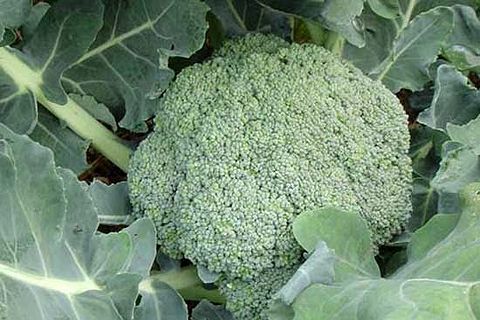

Calabrese - 90 days pass from the first shoots to technical ripeness. The heads are medium in density. The weight of the central head of cabbage is up to 400 g, after which 6 - 7 heads grow on the side of the crop, weighing up to 100 g.
Konpakta - 100 days pass from sowing seeds to harvesting heads of cabbage. The culture grows very compactly, it can be planted in heaps. The head is in the form of a dome, large, with small flower buds.
Monton F1 - has an average ripening period and a raised foliage rosette. The heads are large, weighing up to 800 g, greenish-gray, medium density, good taste.
Senshi - vegetative period 110 days. The head of cabbage is large, in the shape of a dome, with medium-sized flower buds, the cabbage lies after harvest for a long time.
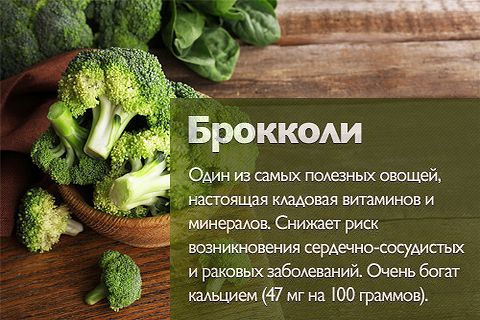

Fortune - the variety has an average ripening period and a raised foliage rosette. Head of cabbage is greenish-gray, average density, weight up to 150 g, good taste.
See also
How to get cabbage seeds yourself at homeRead
Caesar - has large, hard, greenish-purple heads.
How to understand that the color has begun?
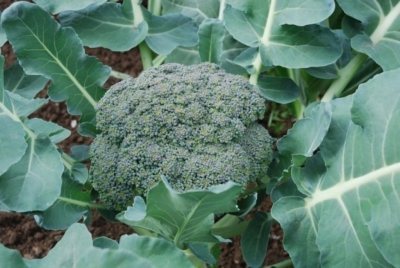

One of the first signs by which one can judge the imminent flowering is a color change.
Cabbage that is usable should be dark green in color.... There should be no dry, rotten spots on the head.
In order not to miss the picking time, you need to carefully monitor the head of cabbage. The processes that extend from it to the sides begin to change color. At first, they are covered with brown - yellow spots. After a few days, the head is covered with flowers.
For a good and generous harvest of broccoli, it is important to know all the subtleties and nuances of growing this crop. With proper care, broccoli heads should not have inflorescences. If yellow flowers appear on broccoli, then such cabbage becomes unsuitable for food. and such a product cannot be saved.
If you find an error, please select a piece of text and press Ctrl + Enter.
Is it necessary to wash the cabbage?
Housewives often ask: is it necessary to wash cabbage? Definitely yes. But not after cleaning the garden or shopping at the store, but before preparing the dishes.
- Prepare a large bowl, fill with water, add 3-4 tsp. vinegar.
- Dip the inflorescences in the solution for 12-15 minutes to remove debris and insects.
- Remove vegetables, rinse, blot to remove moisture.
- Use for cooking immediately.
Broccoli heads should be in the refrigerator half an hour after they were brought from the store or plucked from the garden. Do not waste time, otherwise vegetables will lose their nutritional value and freshness.
What should a gardener do?


Such a vegetable is not harmful to the body, since no harmful substances accumulate during the flowering period... But it becomes tough and not juicy, with a bitter taste.
Therefore, most often, this broccoli is not used for culinary purposes. This crop is used to feed livestock.
but having found flowering, do not rush to completely remove the plant from the garden... Many varieties of broccoli cabbage, after the central head is cut off, additional heads are released from the lateral sinuses. These lateral heads, with proper care, can grow to large sizes.
Short term refrigerator storage
How to store broccoli in the refrigerator:
- Sprinkle each head with clean water from a spray bottle.
- Then wrap with a clean cotton napkin, towel.
- Refrigerate and enjoy fresh taste and aroma for 3-4 days.


For a list of ethylene-emitting fruits and vegetables that are undesirable for broccoli, see our article on storing fresh cucumbers.
It will help preserve broccoli and a simple wrap with a damp paper towel or packing in plastic bags (you do not need to close them). After that, the valuable product is placed in a cool place, where it will remain fresh for 2-3 days.
How to keep the cabbage fresh for the next week? Make a green bouquet, place in a jar of water, cover with a bag on top. Change the water every day, and hole the polyethylene for air circulation. Keep the broccoli refrigerated and enjoy freshness for 6-7 days.
It is unacceptable to keep cabbage in a tight plastic bag, airtight container. In order for it to retain its nutritional value, not to become moldy, you need constant access to fresh air.
Prevention of crops
Before you start growing a vegetable in the open field, you need to understand that hot and dry weather is the main enemy for the culture and so that it does not bloom, in the heat it is necessary to provide abundant watering for the entire length of the root system. If the air is too dry, then additional moisture can be provided using low containers of water. They are placed between cabbage beds.
To retain moisture, you can mulch the soil under the cabbage.
To avoid early flowering, do not allow low temperatures during cultivation.... The cabbage planted in the garden from hypothermia will be saved by a shelter with warm material or an ordinary greenhouse film.
It is also necessary to feed the plant, starting with seedlings and ending with a cut of the central head:
- The first time broccoli is fed a week after planting the seeds.
- The second feeding is recommended after 2 weeks.
- For the third time, fertilizers are introduced into the stage of inflorescence formation.
- The fourth and final feeding is carried out after cutting the central head of the cabbage.
Top dressing is most conveniently carried out with a complex mineral fertilizer.
Cauliflower growing
The cauliflower seedling stalk has become thin, even dried out a little from the bottom. How to save?
Such seedlings should be thrown away, as this is a sign of an incipient black leg disease (the lower part of the stem is thin and black). Too thickened crops and excess moisture in the soil contribute to black leg disease. Thickened crops are strongly stretched, while the lower part of the stem begins to dry out. To avoid this, it is enough to at least soil such seedlings with earth, if there is no time to plant them.
Why doesn't the cauliflower tie the head?
The reason may be lack of nutrition and moisture during growth, planting of overgrown seedlings, dry soil, especially at an early age, too hot weather, or, conversely, prolonged cold snap during growth. Cabbage should not be grown in partial shade or in an area that is only sunlit for half the day.
Why does cauliflower tie a very small head?
This happens in the case of insufficient nutrition and insufficient moisture in the soil and air, on poor soils, on dense, clayey, acidic soils, with keel disease, with a lack of trace elements, especially boron and molybdenum.
Why does a cauliflower head crumble?
Either the head has grown, or you have introduced an excess of nitrogen into the soil, especially with a lack of potassium, or the seedlings grew with a lack of moisture.
The reasons for the appearance of a fleecy, loose head: strongly elongated, overgrown seedlings, lack of moisture, prolonged cold snap, intense heat (above 25 ° C).
By the end of September, our cabbage has not yet tied its head. Can it be left in the growing garden or can it be destroyed by frost?
Generally, in autumn, cauliflower is more resistant to light frosts than at an early age, and is able to tolerate frost damage up to -3 ... -4 ° C, but just in case it is better to cover it with lutrasil. So take your time to tear up plants with large leaves that have not yet tied their heads by the end of September.
Or do so. If the cabbage has grown a good leaf apparatus, but has not tied the head by the end of September, it can be grown to the very frost in the greenhouse and even in the basement, in the dark. To do this, they dig it out with a lump of earth, put it in boxes tightly to each other and leave it in a greenhouse or basement. The cabbage will tie or grow the newly set heads to their normal size due to the nutrients it has accumulated in the covering leaves.
Frozen gifts of the fields
Try to keep the broccoli frozen for the winter. Experienced housewives claim that when properly frozen, the culture retains an excellent appearance and maximum nutrients.
We start with preparation
To freeze broccoli for the winter, you need to properly prepare it. Select strong healthy green heads with a diameter of 8-15 cm. Cut the stump, remove the leaves, and disassemble the cabbage into single inflorescences.
Do not forget to get rid of the bugs that may have remained between the flowers before freezing. For this:
- Fill a bowl or bowl with water, add 40-45 g of salt to 1 liter of water.
- Lower the inflorescences, leave for 20-25 minutes, then remove, rinse thoroughly.
- Throw in a colander to allow excess moisture in the glass.


Freezing without blanching
You can freeze broccoli for the winter without blanching:
- Rinse first, fold it over a cloth to dry.
- Then pack in bags and freeze.
Some housewives complain that after defrosting, the cabbage changes color, becomes soft. Yes, it will not be as firm as before, but the color will remain. To prevent the inflorescences from becoming soft, it is recommended to freeze them using a different recipe.
First, blanch
To freeze broccoli for the winter and maintain its firmness, it must first be blanched.
- Prepare 2 pans. Put one on the fire, adding 1 tsp. citric acid in 1 liter of water, fill the second with cold water with ice.
- Dip broccoli in boiling water in portions, blanch for 1-2 minutes. Then immediately cool them in ice water to stop heating processes.
- Throw the inflorescences on a napkin or towel, let the excess liquid drain. In order for the frozen product to retain its nutritional value, it is completely cooled.
- Pack the semi-finished product in plastic bags, place in the freezer. Freezing it will keep it fresh for the next 8-10 months.
There are varieties that, even with blanching, even without it after defrosting, are suitable only for puree soup. If you don't know how your cabbage will behave, put a small piece in the freezer for 24 hours. During this time, nothing will happen to the whole batch, and having thawed the "sample", you will know what it is good for.
And finally, a video from which you will learn how to cook broccoli to preserve all vitamins:
Now you know all about the correct freezing and other options for storing broccoli. And with the onset of winter cold, you can easily prepare a lot of delicious dishes, giving the body the vitamins that are in cabbage.
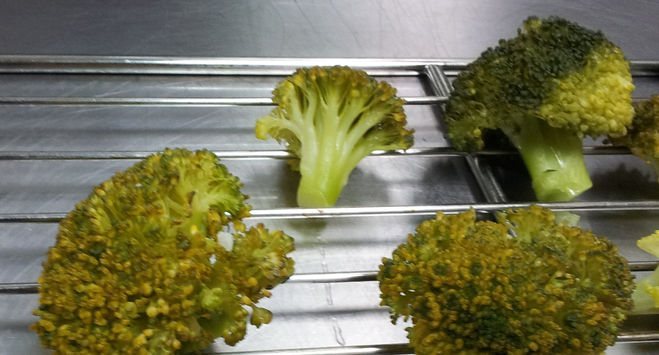

Green broccoli with unopened flowers is healthy and rich in vitamins and minerals. Broccoli can turn yellow in two cases:
- the flowers bloomed on it and turned yellow
- during storage, green (unblown) flowers wilted and acquired a yellowish tint.
The result in both cases is the same - loss of taste and almost all nutritional qualities.
And now the answer to the question posed: is it possible to eat such cabbage? There is, of course, you can. But why? Almost nothing useful was left in it.
Broccoli, like any greens, should be eaten fresh, preferably just picked. Withered greens can, perhaps, slightly revive the taste of a dish, but that's all.
Broccoli is a vegetable product, so if it turns yellow and this happens from the fact that it wilted a little, then there is nothing wrong, since there is no such bacterial nightmare as with protein food that begins to deteriorate, it is not even close.
In our city, a leading supermarket chain sells such broccoli at a discount. And people take and eat and I ate and everything is fine. Moreover, it even happens that they sell one that begins to turn black from above.
The main thing is you, smell it, so that it does not start to rot. Well, this happens if you keep it in a bag for a long time and there will still be moisture there, then if it decays badly, then throw it away.
How to choose the right site and prepare the seeds
How to plant broccoli correctly so that the heads are tied?
Plant broccoli in the area where mustard, carrots, beans, potatoes, phacelia, oats, onions, lupines, beans, peas, wheat, cucumbers grew before. Do not plant on the garden bed where cabbage, tomatoes, beets, radishes, turnips, radishes grew.
Dry seeds are poured into water with a temperature of +50 ° C for a quarter of an hour, then washed in water. Pour onto a damp cotton towel and refrigerate for 24 hours. Then the seeds are dried and sown.
How much broccoli is stored
The storage time of broccoli depends on the temperature and humidity of the air. The lower the temperature, the longer the cabbage is stored:
- in the refrigerator, at a temperature of 4 ° C to 7 ° C - no more than 3 weeks;
- in a cellar, where the temperature is stable from 0 ° C to 3 ° C - up to two months;
- frozen (minus 18 °) - from 6 to 8 months.
If you decide to store in a refrigerator or cellar, then keep in mind that the air humidity must be at least 90%.
Storage features
There are several ways to make the vegetable sit for as long as possible. First, you need to be more attentive to the nuances of the harvesting technique. Cut off the head of cabbage for storage, preferably with a stalk 8-10 cm long, and not under the inflorescence itself.
Did you know? According to statistics, 79% of US residents eat broccoli. Americans eat 76 thousand tons of this vegetable annually.
It should also be remembered that early-ripening varieties are not suitable for long-term storage, in contrast to late-ripening varieties.
The shelf life of broccoli is influenced by temperature, humidity and the quality of the cabbage itself. Cabbage should not be washed under running water before storing it, as this will significantly reduce its shelf life.
Short-term
Fresh cut heads of cabbage are stored for a short time. To do this, you need to place them in the refrigerator in a plastic bag with small holes for ventilation or in a special container. In the refrigerator, cut broccoli heads are stored for no more than 3 weeks at a temperature of + 4 ... + 7 ° С. The optimum humidity is 95%.


Freshly cut broccoli can be stored at room temperature, but no more than 2-3 hours, otherwise the healthy vegetable may wither and deteriorate.
Long-term in the refrigerator
For longer storage, the vegetable is frozen, in this form it can be stored in the freezer for 6 to 10 months.
Did you know? The largest broccoli in the world was grown by the American John Evans. The weight of the vegetable was 15.8 kg.
Shock freezing, which means freezing in a very short period of time, preserves all the useful properties of the vegetable and helps to preserve its presentation. This will allow the broccoli to sit as long as possible.
Composition, BJU and calorie content of broccoli (boiled, raw)
Scientists managed to study in detail the beneficial properties and contraindications of broccoli cabbage. The inflorescence (head) is of nutritional value. It is cut off in an underdeveloped form. If you miss the moment, the buds will turn into flowers. Such a vegetable will become unsuitable for eating.
Chemical composition of broccoli
The edible part of the inflorescences contains (in terms of 100 g of product):
- water - 90 g;
- proteins - 3 g;
- carbohydrates - 5.75 g;
- fats - 0.35 g;
- ash - 0.9 g.
The vegetable contains such essential acids as arginine, lysine, threonine, tryptophan, phenylalanine and others. Its pulp is rich in vitamins A, C, gr. B, E, K, PP. Of the minerals, the largest amount contains magnesium, potassium, calcium, phosphorus, sodium. Inflorescences are rich in iron, copper, manganese, zinc, selenium.
How many calories are in broccoli
The energy value depends on the growing conditions of the crop, region and variety. She is within 30-34 kcal/ 100 g of raw product. The percentage of BJU broccoli is 11: 3: 20. [adsens3] Heat treatment has little effect on energy value. Calorie content of boiled broccoli - 35 kcal / 100 g. During frying, the inflorescences absorb fat. Nutritional value of fried broccoli - 45 kcal / 100 g.
Compare the composition
Everyone chooses vegetables for themselves based on taste preferences and health. A comparative table will help you objectively evaluate cauliflower and broccoli.
The amino acid composition of cauliflower and broccoli is the same, but the latter is superior in quantitative content to some amino acids. Broccoli is also more nutritious than its cousin. But cauliflower is ahead of broccoli in terms of the amount of minerals it contains.
Broccoli and cauliflower get along well in one plate and harmoniously complement each other's useful qualities. Cauliflower tastes better and is healthier when salted, where it is not cooked. It is preferable to use broccoli baked with a minimum cooking time.
The product has a low calorie content - 100 g contains about 34 calories, while 7 g are carbohydrates, and 3 g are proteins. But on the other hand, the elemental composition of cabbage is very rich. It includes:
- dietary fiber, which occupies 10% of the volume of the product;
- manganese and sodium;
- phosphorus and calcium;
- magnesium and selenium;
- iron, zinc and copper;
- amino acids.
Cabbage also contains rare organic compounds that have anti-cancer effects.
The product is rich in vitamins:
- a huge number of C and K;
- B9 and B6;
- BUT;
- B2, B1, B3 and B5, as well as E.
The presence of all these substances makes the product very valuable for immunity.
Why does broccoli turn into color?
Broccoli inflorescences, which are used for cooking, may bloom ahead of time.
Let's consider the main reasons why broccoli went in color without gaining its mass:
- insufficient amount of nutrients, macro- and microelements, as well as their excess;
- change of temperature: at temperatures above + 25 ° C, the head of cabbage turns into color;
- interruptions in watering mode: due to a lack of watering, the vegetable will stop tying and go into color;
- untimely harvest: non-observance of the growing season leads to flowering of the vegetable.
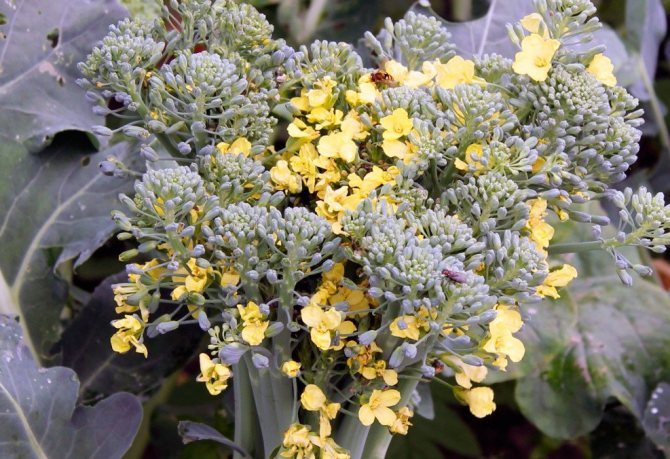

Reasons for the absence of ovaries on broccoli cabbage
Often, it seems that all gardeners do the right agricultural technique, they planted seedlings on time, but there is no ovary on the cabbage. Broccoli is not tied in any way, but massively goes into color. The reasons are both single and complex. The main thing is to know how to fix it quickly in the current season, and how to secure the cabbage for the next year. And beautiful and tasty heads of cabbage will not keep you waiting.
Reasons for the absence of an ovary:
- Insufficiently abundant, as well as rare watering of plantings.
- Unsuitable temperature conditions (too high or low air temperature).
- Deficiency of nutrients in the soil and untimely feeding.
- Too much nitrogen applied to the soil and on the sheet.
- An error in the selection of cabbage varieties for cultivation.
And also problems in the cultivation of broccoli arise from:
- Too darkened area, lack of direct sunlight.
- The acidity of the soil also affects. On acidic soils, you should not expect beautiful and tasty heads of cabbage.
- Heavy soils that impede the access of oxygen to the roots are also unsuitable.
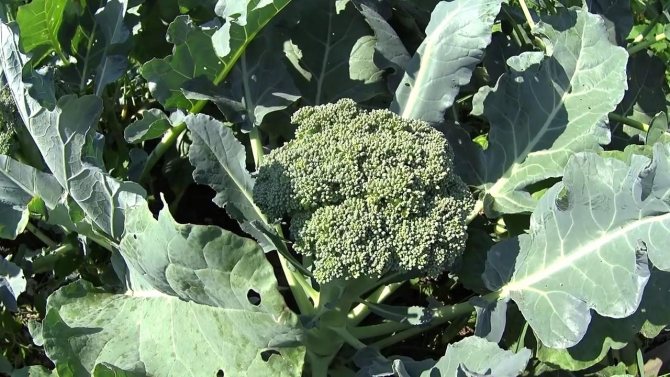

Lack of moisture in the soil
Broccoli is a moisture-loving culture. Especially a lot of moisture is required at the time of the formation of the leaf outlet and, of course, when the heads are set. And also at the time of ovary and maturation of the heads, it is recommended to bring the air humidity to 80-85%. Otherwise, the foliage will become smaller, and the inflorescences themselves will become loose. The frequency of watering during the hot season should be at least every 1 day.
Moreover, the earthen lump in the root zone should get wet to a depth of 40 centimeters. Loamy soil is optimal for growing, but it is permissible to grow on sandy loam. And also one should not forget about the alternation of watering at the root with irrigation by sprinkling. Especially if the humidity is low. But with high humidity, you need to monitor the appearance of caterpillars, snails and slugs on the leaves. For them, cabbage is one of their favorite delicacies.
See also
How to plant cabbage in open ground with seedlings, distance, timing and temperature
To read
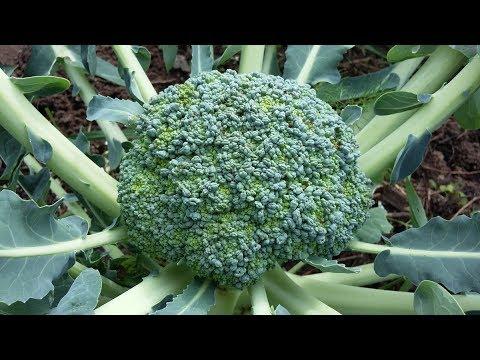

Unsuitable temperature
To a large extent, weather conditions affect broccoli's ability to set heads.If the weather in summer is cold and humid, or vice versa, there is high heat and widespread drought, then you can not hope for a good harvest. In order to successfully grow cabbage and harvest a rich harvest, it is necessary to take into account the influence of the temperature factor.
- Broccoli really does not like sudden changes in temperature.
- Dry air and intense heat also help cabbage to bloom.
- In extreme heat conditions, it is necessary to grow plants with significant shading. And also it is obligatory to shade young plants from the scorching sun.
- Optimum temperature for growing: + 16C, + 18C degrees, and humidity not less than 60%.
- At air temperatures above +25 C degrees, cabbage is likely to begin to bloom.
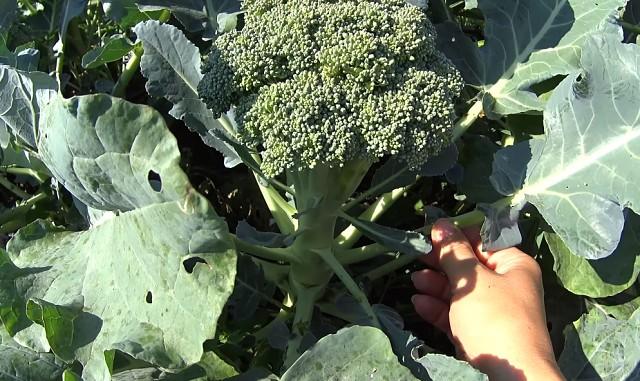

Nutrient Deficiency
For growing broccoli, fertile soils with a neutral level of acidity or slightly alkaline are suitable. The danger is a deficiency or, conversely, an excess of nutrients in the soil. An excess of nitrogen provokes a rapid growth of the vegetative mass. As a result, the cabbage heads are not tied, the plant “fattens”, the trunk grows in length, and large leaves grow rapidly.
And, on the contrary, on poor soils and in the absence of additional dressings, the heads will not tie.
This plant consumes a lot of nitrogen and potassium from the soil. If the soil is not over-fertilized, in the fall they prepare the beds for the spring planting of cabbage. Up to 10 kilograms of organic matter (rotted manure) and 50 grams of granular phosphorus-potassium fertilizers are introduced.
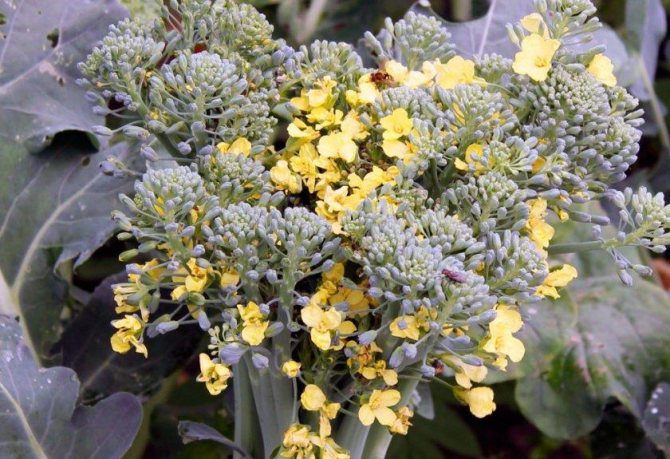

It is necessary to monitor compliance with crop rotation, do not grow cabbage after related plants from the cruciferous family. When choosing green manure, one should take into account that mustard is not suitable in this case. She belongs to the same family with cabbage, so there may be similar diseases. The best predecessors are legumes, potatoes, or carrots.
Mistakes when choosing a variety
The harvest in the season directly depends on the correct choice of the variety. Broccoli, on average, takes a month or one and a half (30-55 days) from transplanting to harvest. It is important not to delay the planting of the crop. The gardener chooses the timing himself, depending on the region where the site is located, and how early the heat sets in the region. For example, in the southern regions, it is advisable to grow early maturing varieties. Then the danger of the crop falling under the peak of the summer heat will be reduced.


Particular attention should be paid to the quality of the planting material. Weak, low quality seedlings or poor, small seeds can cause poor yields. It is strictly forbidden to collect seeds from diseased plants. Before sowing seeds obtained by self-collection, they must be sieved (calibrated), and the largest ones must be planted.
Broccoli cabbage - useful properties and contraindications
Vegetable culture is used in cooking and as a prophylactic agent, beneficial to health; the benefits and harms of broccoli cabbage are associated with its composition. The vegetable has minimal contraindications.
So far, only individual intolerance to the components has been found. The beneficial effects of the product are well studied:
- anti-inflammatory;
- antioxidant;
- anti-cancer;
- mild laxative;
- anti-sclerotic;
- hepatoprotective;
- anticarcinogenic;
- absorbent.
Useful properties of broccoli cabbage
- Improves digestion - dietary fiber has a positive effect on intestinal motility.
- Reduces pain and removes nausea with duodenal ulcer and gastritis.
- Increases appetite, eliminating dyspeptic symptoms in liver diseases.
- Promotes the prevention of atherosclerosis - absorbs cholesterol in the intestine and does not allow it to be absorbed into the blood.
- It is useful in the dietary nutrition of patients with cholelithiasis and gout - there are very few purine bases in the product (4 times less than in cauliflower).
- Fresh juice has an antibacterial effect on Mycobacterium tuberculosis and Staphylococcus aureus.
- Acts as an enterosorbent when the body is damaged by salts of heavy metals, poisons, radionuclides.
Is it okay to eat yellowed broccoli
There will be no particular harm from yellowed asparagus. If there is no rot on the inflorescences, they can be boiled and fried in batter. However, the benefits of the product should not be expected.
Vitamins are destroyed during storage... The older the asparagus, the less glucosinolates (nutrients with anticarcinogenic properties) it contains. And the taste of the dish will be worse.
The use of broccoli in cosmetology
The medicinal properties of broccoli are prized in traditional medicine. It is advised to consume the product at least in small quantities:
- with hormonal disruptions;
- with food poisoning and other intoxications;
- with cardiovascular ailments;
- with high cholesterol levels;
- with poor metabolism and difficulties with bowel movement;
- to strengthen nails and hair;
- for skin care;
- with a wide range of diseases of the stomach and intestines.
With pancreatitis
In acute inflammation of the pancreas, the diet is very strict - and broccoli is not included in the list of permitted foods. But 2-3 weeks after the aggravation subsides, cabbage will be beneficial if you eat it boiled, little by little, without salt and spices.
With gastritis
For gastritis and even stomach ulcers, they eat boiled, stewed or steamed broccoli. Carotene in its composition helps relieve inflammation and promotes rapid recovery of mucous membranes.
With gout
Asparagus, like many of its types, contains purine compounds. Unfortunately, this imposes a ban on the use of the product in case of exacerbation of gout. Even in small quantities, you can eat a vegetable only after consulting a doctor.
With cholecystitis
In case of violations of the outflow of bile, you will have to give up fresh broccoli, since it irritates the gallbladder. But you can still use boiled or stewed cabbage.
Broccoli has turned yellow, can I eat it or not?
If you notice yellowness on broccoli, do not rush to throw it away. This indicates improper storage, but this does not mean that it cannot be eaten. The yellowed broccoli can be eaten, it just contains less nutrients than a fresh "beautiful" vegetable.
Low-calorie foods also include spinach, cauliflower, pumpkin, cucumber, celery, peppers, tomatoes, and mushrooms. But this is not the whole list of foods that will help you feel lighter and help you stay fit.
Broccoli properties


It's no secret that broccoli has medicinal properties. This is due to the large amount of active substances that it contains. They effectively improve and restore the general condition of our body.


For example, the presence of potassium in broccoli well regulates the body's water balance, iron promotes the rapid formation of new blood cells, and iodine perfectly supports the thyroid gland and the endocrine system.
Why broccoli is good for women
The vegetable is characterized by increased biological activity... The benefits of broccoli for women are beneficial effects on the nervous system. The product helps to improve the motor function of the intestines and the work of the digestive tract, normalizes metabolism.
Nutritionists recommend using broccoli slimming... In the inflorescences there is tartronic acid, which is capable of preventing the transformation of carbohydrates into fat and cholesterol in case of excess body weight and the first degrees of obesity.
For example, using a vegetable in such dishes:
For personal hygiene and cosmetic procedures, take broccoli seed oil. It softens the lips and skin of the hands. Can be used as an additive for masks, conditioners, hair shampoos.
The product contains enough calcium and phosphorus to strengthen bone tissue, which is especially important for women during menopause. Doctors also recommend it to support immunity.
Benefits of broccoli during pregnancy
- Regulates salt metabolism in the body, helping to remove excess fluid, which is especially important in the second half of pregnancy.
- The inflorescences contain folic acid, which is useful for the development of the fetus.
- Helps relieve constipation in pregnant women.
- It has a positive effect on immunity and protects the body from infections.
Can broccoli be used for food if it blooms?
In the flowering stage, it is recommended to use it for cooking, since all the nutritional and vitamin complexes in it are preserved, only the presentation of the plant deteriorates and the taste deteriorates slightly. In blooming cabbage, no poisons and substances harmful to humans accumulate.
During flowering, cabbage leaves will taste bitter, the stems will become fibrous and tough. During this period, the vegetable directs all its strength to seed formation. In some countries of the world, blooming broccoli is used to prepare first courses.
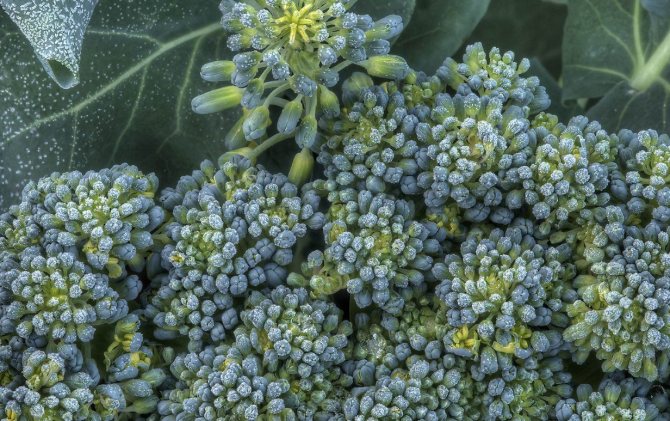

Benefit
Broccoli is an extremely healthy vegetable. The calorie content of 100 g fresh asparagus is 28 kcal, boiled - 34 kcal, fried - 46 kcal. A vegetable is considered to be a low-calorie product, therefore it is recommended to use it by nutritionists to normalize body weight.
We advise you to learn more about early, mid and late maturing varieties of broccoli.
The energy value of a vegetable per 100 g is:
- proteins - 2.8 g (3.41%);
- fats - 0.4 g (0.62%);
- carbohydrates - 6.6 g (5.16%);
- dietary fiber - 2.6 g (13.0%);
- water - 89.3 g (3.49%).
- The beneficial qualities of broccoli depend on its chemical composition and are as follows:
- normalizes the functioning of the kidneys, liver and gallbladder;
- promotes the elimination of toxins, carcinogens and heavy metals from the body;
- protects the body from the formation of malignant (cancerous) tumors;
- reduces the risk of myocardial infarction and stroke by strengthening blood vessels;
- normalizes intestinal motility, relieves chronic obstruction;
- restores the work of the nervous system;
- due to the content of vitamin B9, it has a positive effect on the body of pregnant women;
- normalizes metabolism, and also helps to reduce excess weight;
- regular use prevents the development of atherosclerosis and the onset of premature aging of the body.
Broccoli is also called stalked cabbage, since the side leaves (petioles) are suitable for consumption.


Harm
Despite all the benefits, broccoli can bring harm to the human body.
- You should not eat cabbage raw or fried for people who:
- suffer from increased stomach acidity;
- have stomach ulcers, as well as acute gastritis and pancreatitis;
- have an individual intolerance to the product.
We stimulate the formation of ovaries
An effective agricultural technique to prevent premature flowering of cabbage will be to stimulate the ovary. For this, there is a line of drugs that will actually help gardeners. These are domestic stimulants Ovyaz, Boric acid, Zeovit Ovyaz Plus, Epin Extra, Valagrovsky (Italian) stimulant MC Set. It is also marketed under the name MC Ovyaz.
It is extremely important to remember that the leaves and heads of cabbage are covered with a waxy coating. And when spraying over the leaf, an inexpensive but effective adhesive must be added to the stimulant. But you can safely use laundry soap as this substance. At the dacha, it is always at hand.
Why broccoli is useful for cancer
Regular consumption of asparagus cabbage (preferably steamed) will help the body resist the growth of cancer cells. It has been scientifically proven that cabbage contains substances that affect oncological diseases. These are indole-3-carbinol, diindolylmethane, and a precursor to sulforaphane.
However, you can get a daily dose of indole-3-carbinol by eating 5 kg of raw cabbage heads per day. This is unrealistic.Therefore, the substance is consumed in the form of extracts. The daily dose of sulforaphane is contained in 250 g of raw product. In broccoli seedlings, this substance is 50 times more.
Edible portions of broccoli
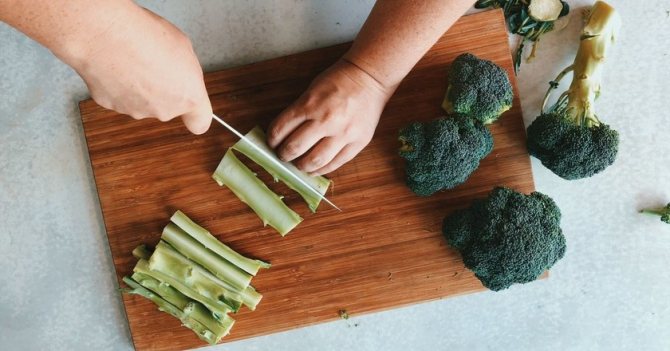

Broccoli leaves and stems contain several times more nutrients than inflorescences. It looks like this: 30 grams of broccoli leaves contains a third of the daily value of vitamin A and almost half of the daily intake of vitamin C.


The stems contain a lot of sulforaphane, a substance that has anti-inflammatory properties and prevents cell destruction, preventing the formation of tumors.
Method of cooking broccoli that has bloomed
This vegetable can be eaten both raw and after heat treatment. Broccoli can be boiled and baked in the oven. It is added to omelets, pizzas, mashed soups, salads, pies, etc. But it should be remembered that frying the vegetable is not recommended, since harmful carcinogens are released under the influence of high temperature. The ideal cooking option is steaming.
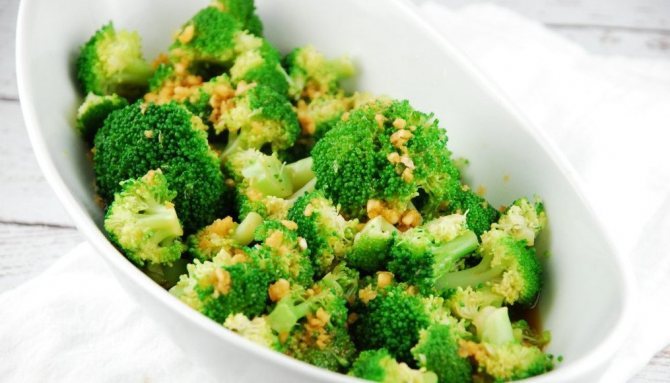

Every summer resident wants to get a good harvest of broccoli. Having studied the basic rules of breeding, as well as the growing conditions, you can achieve the desired result.
How to make broccoli tasty and healthy
There are about 200 varieties of broccoli. Their inflorescences are almost yellow to green and purple in color. Recipes for making broccoli are not plant-specific. They contain such culinary techniques as frying, baking, boiling. The inflorescences are used to prepare salads, soups, casseroles and side dishes. All types of cheeses, cottage cheese, rice, mushrooms, tomatoes, basil go well with the product.
Chicken fillet with broccoli and bell pepper
The recipe uses fresh cabbage and peppers. If necessary, they can be replaced with ice cream. Ingredients:
- fresh broccoli - 400 g;
- vegetable oil - 4 tbsp. l .;
- chicken breast - 500 g;
- onions - 2 pcs.;
- bulgarian pepper - 3 pcs.;
- tomatoes - 2 pcs.;
- salt pepper.
Preparation:
- Fry the diced onion in a saucepan.
- Add the chopped peppers to the saucepan and continue to fry.
- Separate the tomatoes from the skin and chop (you can use a grater).
- Add tomato paste to a saucepan and bring to a boil.
- Cut the chicken fillet into cubes or large cubes and add to the vegetables.
- Put broccoli in a saucepan, mix the ingredients.
- Cover the saucepan with a lid and simmer on low heat for 20 minutes.
- When serving, sprinkle with chopped herbs, you can add cream.
Broccoli puree soup with cream
You can prepare 2 servings from the offered products. Cooking time is about 40 minutes. Ingredients:
- broccoli - 250 g;
- cream 35% - 100 ml;
- onions - 1 pc.;
- garlic - 1 clove;
- vegetable broth - 0.5 l;
- potatoes - 1 pc.;
- salt, pepper, nutmeg;
- white bread croutons.
Read about the nutritional value of kohlrabi cabbage here.
What is rutabaga, what does it look like and why should you eat it?
Preparation:
- Chop the potatoes, chop the onion and garlic.
- Disassemble the broccoli into inflorescences.
- Pour vegetables in a saucepan with hot broth and cook for 10 minutes.
- Grind the ingredients with a blender.
- Add cream and simmer for another 20 minutes.
- Toss in pepper, salt, nutmeg and boil.
- Serve with croutons.
Species diversity


Asparagus, aka broccoli Broccoli has two varieties:
- Calabrian, looks like a large green mushroom with a short thick stem.
- Asparagus or stem, inflorescence caps grow on long stems. It is mainly grown in Italy and America.
The first variety of broccoli is grown and sold in Russia.
Types of broccoli cabbage are divided into varieties and hybrids. There are varieties of different ripening periods: early, medium ripeness and late.
I would especially like to highlight the following varieties and hybrids:
Early: Vitamin, Batavia F1, Tonus, Curly head. Vyarus.
Average: Atlantic, Dwarf, Fortune, Monton F1, Caesar.
Late: Lucky, Marathon, Greenia, Parthenon F1.
Many hybrids Dutch selection: Corvette, Agassi, Continental, Ironman.
There are varieties and hybrids that grow better in certain regions. IN middle lane proved to be excellent: Baro star F1, Fiesta, Comanche.
In the Urals perfectly bear fruit: Lazar, Linda, Tribute, Arcadia.
Broccoli is a must-have cabbage if you care about your health and want to eat healthy food.
Wrong harvesting regime
The main rule for harvesting is the timely cutting of ripe heads of cabbage. If you miss the moment, broccoli will bloom.
Its color grows rapidly and covers the entire head of the cabbage in a few days. Blooming vegetables lose their tender juicy core, become tough and tasteless. Broccoli is grown for vitamins and micronutrients: if you overexpose a head of cabbage outdoors, it spoils and does not cook well - such a dish will not do any good.
The first signs of flowering
An overexposed vegetable is gradually changing - this is the first sign by which one can judge that cabbage is not suitable for consumption. In the normal state, cabbage is squeezed into dense, dark green buds. The head should be free of stains, signs of rot or dry heads.
Be sure to monitor the state of the head of cabbage: by its appearance, the time of harvest is determined. Immediately before the flowering of the head of cabbage, extending from the main stem, its processes begin to turn yellow. Irregular yellow-brown spots appear first. Within a few days the head of cabbage becomes covered with a characteristic color, which is difficult to get rid of.
If the cabbage is blooming, it is too late to pick it. The crop is cut and used for household needs (feeding livestock). Prudent housewives lend themselves to heat treatment, but it is no longer possible to get all the useful substances from cabbage. A product that has bloomed rarely causes negative reactions, but it is not recommended to eat it.
Improper storage


If stored improperly, cabbage will bloom
A healthy crop for sale or home storage can also bloom. Cabbage is stored in 2 ways:
- for a short period - within 2-3 days;
- for a long time - several weeks.
If you manage to grow a healthy vegetable without flowering, it is properly stored. Even a recently healthy head is capable of becoming covered with yellow flowers in a few days. In this case, the product loses all its useful properties.

